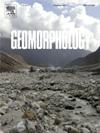Erosion and potential geological hazards chain in the East African Rift System controlled by volcanic sediments properties and geological structure
IF 3.1
2区 地球科学
Q2 GEOGRAPHY, PHYSICAL
引用次数: 0
Abstract
The East African Rift System (EARS) hosts extensive unconsolidated volcanic sediments whose unique physicochemical characteristics interact with geological structure to drive erosion and geological hazard cascades. Focusing on the Central Kenyan Rift (CKR), this study integrates geotechnical testing, sediment property analysis, and geophysical imaging to decipher the mechanisms controlling erosion evolution and associated geological hazard chains. Key findings reveal: (1) Four characteristic erosional landforms (sinkholes, pipes, gullies, badlands) developed in CKR volcanic sediments; (2) Volcanic sediments exhibited high vulnerability indices with >40 % macroporosity (>32 μm), bimodal grain size distributions, and alkaline profiles with surface Na+/metal enrichment. (3) Electrical resistivity tomography (ERT) delineated the erosion-piping networks, while Shallow seismic exploration (SSE) identified the strata dislocation patterns comprising stratal fracturing, normal faulting, reverse faulting, and uplifts. (4) Synergistic coupling between sediment properties and geological structure governs erosion and potential geological hazards. This integrated study advances understanding of erosion mechanisms of volcanic sediments in rift-related geological hazard cascades, providing critical insights for infrastructure resilience and land-use planning in active tectonic settings.
求助全文
约1分钟内获得全文
求助全文
来源期刊

Geomorphology
地学-地球科学综合
CiteScore
8.00
自引率
10.30%
发文量
309
审稿时长
3.4 months
期刊介绍:
Our journal''s scope includes geomorphic themes of: tectonics and regional structure; glacial processes and landforms; fluvial sequences, Quaternary environmental change and dating; fluvial processes and landforms; mass movement, slopes and periglacial processes; hillslopes and soil erosion; weathering, karst and soils; aeolian processes and landforms, coastal dunes and arid environments; coastal and marine processes, estuaries and lakes; modelling, theoretical and quantitative geomorphology; DEM, GIS and remote sensing methods and applications; hazards, applied and planetary geomorphology; and volcanics.
 求助内容:
求助内容: 应助结果提醒方式:
应助结果提醒方式:


